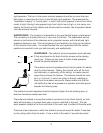
ROOM REFLECTIONS
The most troublesome room reflections are usually the early reflections of the LCR
speakers off the floor, ceiling and side walls. These reflections reach the listener’s ears
delayed with respect to direct sounds and blur the perceived image. They can also
degrade dialog intelligibility, through the same mechanisms.
The design of the THX LCR speakers minimizes the floor and ceiling reflections. As an
extra enhancement, it is often a good idea to place a thick, absorptive carpet between
the front speakers and the listening position, just to further reduce this primary reflection
from floors with hard surfaces. A rug made from wool will generally have more uniform
absorption characteristics than one made from synthetic fibers.
The THX LCR speakers have broad dispersion in the horizontal plane in order to ensure
a wide usable listening area. This design choice can induce reflections off of the side
walls, especially in installations where they are relatively close to the front speakers.
These reflections can be reduced simply by angling the left and right speakers inward
somewhat.
If giving the speakers some “toe-in” is not enough, the next step is the strategic place-
ment of absorptive materials on the side walls. These range from commercially available
fiberglass and dense foam to heavy draperies and even large, overstuffed furniture. The
optimal position for these materials can be found with a small hand mirror and an assis-
tant. Sit at the primary listening position and have the assistant slowly slide the mirror
along the wall. When
you can see any of the
front speakers reflected
in the mirror, mark the
wall at the mirror for later
placement of absorptive
material.
A variation of this
method is especially
helpful in rooms which
are already fairly “dead”
acoustically. Rather than
using absorptive materi-
al in rooms like these, try
using diffusion instead.
9


















